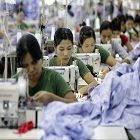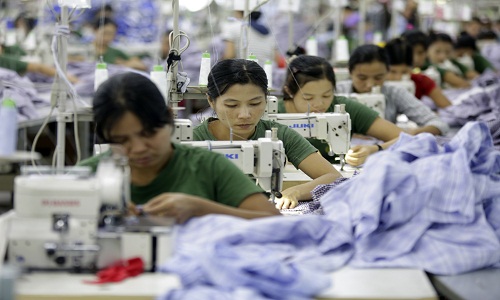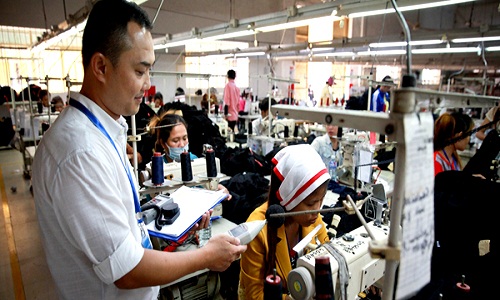FW
The ongoing assessment of supply capacities for textile, apparel and leather products by the East African Community Secretariat in the East African (EAC) region must be handled with utmost care and the outcomes made to truly reflect the situation on the ground. The exercise is meant to facilitate planning for phasing-out of second-hand leather and apparels products, in line with a directive of the last EAC heads of state summit.
The 17th Ordinary Summit of the EAC heads of state, which was themed ‘EAC: Advancing Market-Driven Integration’ held in March in Arusha, Tanzania directed partner states to procure their textile and footwear requirements from within the region where quality and supply capacities were competitively available. The summit directed partner states to sensitise all stakeholders and directed the Council of Ministers to provide it with an annual review with a view to fast-tracking the process.
Even as the region seeks to promote vertically-integrated industries in the textile and leather sector, it is important to gauge the level of preparedness to fill in the gap that will be left by expected ban. The industry may need support measures and incentives to expand investment in order to meet the sudden rise in demand for products. But it is clear that the region does not have the capacity to supply the market with the required amount of garments and shoes. Uganda, for example, has few cotton ginning factories despite being a major cotton producer. The Uganda Manufacturers Associations lists around 30 garment and footwear producers among its members. Although the intent of regional governments in banning second-hand clothes and shoes is noble — to boost local textile industries — that approach may not be the best for now.
Direct-spun polyester staple fiber (PSF) prices in China saw a roller coaster a fluctuation during July and August. The operating rate of PSF industry fell from 80 per cent to 72 per cent in the second half of August and is expected to recover to 80 per cent.
Accordingly, polyester feed stocks are supposed to buoy PSF better in September than in August. As a whole, direct-spun PSF price will rebound in September on better demand while restrained by its high operating rate. A very large part of the growth in polyester has come from China with India and Southeast Asia also contributing. In the case of China, both polyester production and apparent domestic demand for the fiber have been very strong. China accounts for 69 per cent of all polyester fiber production globally, and if India and Southeast Asia are added, these three regions represent 86 per cent of global production.
Polyester staple fiber is available in different deniers with different cut-lengths.PSF is mainly produced in India, China, Taiwan, Indonesia, Vietnam, Malaysia, and Korea. PSF is mainly used for fiber fillings in pillows and sofas. It is also used widely in spinning to make polyester spun yarn which is then knitted or weaved into fabrics.
Vietnam is a member of the TPP and China is not. To counter the adverse impact of the treaty, Chinese textile groups are investing in Vietnam in a big way. Execution of the TPP will pose new challenges to China's textile and apparel enterprises, so companies are building their Vietnam operations with respect to the cost advantages. Even without the TPP, the competitiveness of Vietnamese operations is strong among all Southeast Asian nations and even compared to Chinese production bases. Vietnamese production has several advantages for Chinese companies besides the TPP.
One is relatively favorable trade relations with the world vis-a-vis China. Even before the TPP, tariffs on yarns exported from Vietnam to Japan, South Korea and Europe were lower compared with exporting them from Chinese factories. Production costs are another advantage. Compared to China, labor, electricity and other costs are lower in Vietnam.
Texhong, one of the world's largest yarn suppliers, has been aggressively building up yarn production capabilities in Vietnam. Upon completion, the company's yarn production in Vietnam is expected to become almost on par with its Chinese operation. Manufacturing is going downstream beyond yarn. Production equipment with an annual capacity of 60 million meters of gray fabric, 40 million meters of woven dyed fabric, and seven million pieces of garments will be installed by around November and begin full operation early next year.
Welspun India is paying the price of tripping up on quality standards. The number could be more than Rs 6,000 crores it lost in market value after its second largest customer, the US-based discount retailer Target Corp pulled the plug on $90 million business from its Indian supplier. Where Welspun went wrong was that the sheets and pillows it sold to Target were labeled as made of premium Egyptian cotton but were actually made of another type of cotton.
Interestingly, just a month ago, the Singapore International Arbitration Centre, adjudicating in the case between Ranbaxy Laboratories and Daiichi Sankyo, passed severe strictures on the way the Indian company had hoodwinked its Japanese buyer which paid Rs 19,804 crores in 2008 to buy a majority stake in the company. The Court noted that Ranbaxy deliberately hid information that allegedly implicated its owners and top management in a host of irregularities, from fraud to falsehood, to dupe its new owners.
Significantly, both Welspun and Ranbaxy have been market leaders in their businesses of bed sheets and generics respectively. And both the companies led in a space where India’s factor advantages had made them global leaders in their own fields respectively. Indian manufacturers have a 47 per cent share of the worldwide bed sheets market, while the country is the largest provider of generic drugs globally with Indian generics accounting for 20 per cent of global exports in terms of volume. What comes out of both the stories is that Indian companies don’t care for long term relations by maintaining quality.
Pakistan’s spinning mills that import fabric waste are forced to pay 17 per cent sales tax and 5 per cent withholding tax at the import stage, which they cannot recover due to overall zero-rating status of the textile sector. About a tenth of the total spinning sector uses textile waste as a raw material, they said. Therefore, the Pakistan government continues to collect 22 per cent taxes on import of textile waste used as raw material in manufacturing value-added products in violation of an agreement with the textile sector to charge its supply chain at zero sales tax rates.
On an average, the industry has been importing 10-15 containers per month of waste cotton that is used for manufacturing of socks, gloves, blankets and other value-added products. The spinning industries that rely on fabric waste as raw material of yarn have started feeling the brunt of the move, fearing that they would soon become uncompetitive in the international market due to high input cost.
Since the last four years, the country’s exports are already on the decline. The value-added sector that has started gaining footprints on back of duty-free status granted by the European Union may be the biggest loser of the government’s move.
"While Southeast Asia continues to enhance its role as a global manufacturing hub, Cambodia is struggling with slow growth in domestic garment business. In its attempt to move up the manufacturing value chain Cambodia is challenged with regulatory obstacles, insufficient infrastructure, lack of skilled workforce and slow demand globally. Cambodia’s Garment Manufacturers' Association revealed that the domestic footwear and clothing had fallen 30 percent this year and that political uncertainty had forced more than 70 factories to close or relocate."

While Southeast Asia continues to enhance its role as a global manufacturing hub, Cambodia is struggling with slow growth in domestic garment business. In its attempt to move up the manufacturing value chain Cambodia is challenged with regulatory obstacles, insufficient infrastructure, lack of skilled workforce and slow demand globally. Cambodia’s Garment Manufacturers' Association revealed that the domestic footwear and clothing had fallen 30 percent this year and that political uncertainty had forced more than 70 factories to close or relocate.

Over the past decade the garment industry in Cambodia contributed almost 70-80 per cent of its total export revenue and generated huge scope of employment. In fact, Cambodia has emerged on the global scene as a major garment manufacturer and exporter, with low cost skilled workforce, favorable investment policies, and preferential access to Western markets. The surge in Cambodia's garment industry, combined with two decades of relative political stability and economic liberalization has helped the country rebound from decades of war and build one of the region's fastest-growing economies. However, over time, the garment industry has fallen victim to the country's many political and structural challenges.
Political unrest a dampner
Labour issues being one of the sensitive areas of political conflict, the garment industry is reeling under its heat. Post-2013 election, disputes over wages, working conditions and the role of unions have became highly politicized and massive strikes across the country has left a major impact on its economy. With 2017 and 2018 general elections approaching, Cambodia's political scene remains largely unsettled posing a major setback for the development of the domestic garment industry.
Over the past three years, repeated wage hikes have more than doubled pay for garment manufacturing jobs in Cambodia to $140 a month, putting the country on par with — or above — many of its regional competitors, including Vietnam, Bangladesh and Indonesia. Now, as opposition parties and unions are demanding that the rate increase to $177 per month. As other countries in the region, such as Myanmar and Vietnam, pursue international trade more aggressively, Cambodia's climbing manufacturing wages will continue to erode its competitive edge in the years to come.
Losing its unique position in global value chain

Labour wages in has seen a sharp rise within a very short time period when the country is still struggling to move up the manufacturing value chain and diversify its economy. Of the major garment exporters worldwide, Cambodia is among the most dependent on textile and clothing for export revenue, employment and investment, second only to Bangladesh. Though both countries suffer similar deficiencies in infrastructure and labor productivity, Cambodia's industrial capacity is still well below that of Bangladesh and largely operates at the downstream end of the industrial chain. Cambodia's garment factories are mostly owned by foreign brands, making the industry it vulnerable to external shifts.
Moving up the global value chain has not been an easy way for many countries. Although East Asian economies like Japan, Hong Kong, South Korea, and, more recently, China and Vietnam have managed to transition up, the process has been mostly reactive, peppered with inconsistencies and setbacks spread over decades. Currently, Cambodia has even more hurdles to overcome to transform its economy, including severe infrastructural deficiencies outside its main manufacturing centers, an unskilled labor pool, and high electricity and energy costs.
Over the past two years, investment from China and Japan has enabled Cambodia to broaden its economic activities to construction, service and light manufacturing (auto parts and electronics), despite an overall slowdown in investment. Though these diversification efforts have relieved some of the most pressing concerns over Cambodia's economy, political uncertainty and structural shortcomings is becoming major impediments on its way to economic development.
Indonesia wants to be among the top five textile exporters in the next couple of years. Currently Indonesia is ranked 10th and has a global market share of 1.8 per cent. In 2015, Indonesia's textile exports contributed 1.21 per cent to the nation’s gross domestic product. This labor-intensive industry provides employment to some three million Indonesians.
The market in Indonesia is dominated by cheap textile imports from China, a trend that worsened after the implementation of the Asean-China free trade agreement in January 2010.
So export-oriented textile companies in Indonesia are given tax incentives and gas at lower prices. Vocational schools are being developed to create adequate human resources. Since the textile industry is aiming for a five to six per cent year on year growth, an additional 6,00,000 workers will be needed each year.
A free trade agreement with the European Union would boost Indonesia’s textile exports. Currently it is difficult for Indonesia to compete with Vietnam on markets in Europe and in the US since Indonesia is not engaged in free trade partnerships with these regions. Therefore Indonesian textile exports to Europe are subject to import duties in the range of 11 to 30 per cent, while Vietnam can export its textile products to the European Union without import duties. This makes Vietnam's products much more competitive.
China-focused apparel company Topbi International Holdings declared a positive business outlook for the rest of this year, saying it might benefit from Beijing’s new population policy. The company offers clothes and accessories for toddlers and children aged one to 16, catering largely from the middle-class. As of last January, China scrapped its controversial one-child policy allowing married couples to have two children. Encouraged by the policy, the company is optimistic about sales performance in the second half of this year.
The company is also closely watching structural changes in the market such as online platform transactions, a fast-growing sector. In the first half of this year, Topbi had almost 1,431 outlets in China, up from 1,401 last year. The company will opened more concept stores that would allow it to interact with customers in to increase brand recognition. Established in 2002, Topbi is one of the top 10 domestic apparel brands in China.
Textile exhibition Collection Premiere Moscow will be held from August 31 to September 3. Taking a prominent place in the exhibition would be textiles products from Indonesia. This exhibition will also see the presence of renowned Indonesia designers along with their like: Itang Yunasz Ready to Wear, Ardistia New York, Alleira Batik, and Warnatasku.
According to Achmad Sigit Dwiwahjono, Director General of Chemical Industry, Textile and Miscellaneous Industry Department, this is an effort to strengthen Indonesia's textile industry. Sigit rued the fact that development of textile industry in the last three years has come down significantly. One effort to push it is through the fashion industry. The Ministry of Industry noted that the textile sector investment accounted for 3.68 per cent of foreign direct investment (FDI) and 3.06 per cent of the investment, domestic investment (DCI).
In addition, the data of Creative Economy also shows a 4.9 per cent economic growth in the country every year. Based on this, it is assumed that 31 per cent of the country’s revenue comes from the fashion industry. Sigit also hopes that through these activities, Indonesian textiles and fashion could be popularized worldover.
Durst and Technijet have jointly developed a digital textile system called Swiftjet. Swiftjet is a spraying and drying unit which is connected upstream in actual printing machine and depending on the desired printing result, takes over the chemical pre-treatment of the textile thread. Swiftjet offers process optimization for increasing economic efficiency in textile printing.
Durst is an industrial inkjet specialist. Technijet is a manufacturer of industrial high-pressure cleaning systems. Technijet's long-term experience with high-pressure jets comes in useful when ensuring the exact application of the composition on the material surface. Durst has continuously striven to optimize the economic efficiency and environmental safety of inkjet print production.
Durst’s soft pigment ink system (Alpha P) can be printed on standard material like cotton and polyester without additional binders and wet processes. Alpha P has soft grip and color brilliance and at the same time it reduces water and energy consumption in production.
With the Swiftjet solution, flexibility is further increased, since pre-treatment can be added upstream depending on material and need. Previously independent processes can thus be consolidated and automised, which also contributes to an environmentally friendly production.
The Swiftjet pre-treatment system is adapted for the Durst Alpha Series high-performance inkjet printer and can process print widths of up to 330 cm. Durst will also offer the pre-treatment system as a standalone solution for existing third party technologies.












